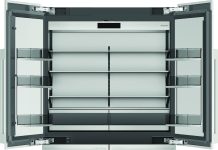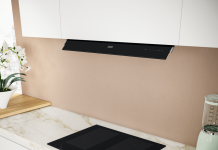By collaborating with the Arçelik Group, a manufacturer of household appliances and consumer electronics, Openair-Plasma has helped improve product quality and manufacturing efficiency while decreasing environmental impact.
In order to reliably bond, imprint or paint materials like plastic, metal or glass in industrial processes, pretreatment of the surface is often necessary. Because of their low polarity, plastics in particular have only very low surface energy, which makes these processes more difficult. Plasmatreat GmbH, based in Steinhagen, Germany, specializes in atmospheric plasma technology and has developed innovative solutions that have become established as safe, efficient and environmentally friendly alternatives to other processes in many industrial applications. Plasma technology makes possible highly effective pretreatment and nano-coating of surfaces made of various materials. When plasma, with its high energy level, comes into contact with materials, the surface properties change, e.g. from hydrophobic to hydrophilic. This fact can be profitably used to improve downstream production processes (Image 1).

Cleaning, activation and coating with plasma
Plasmatreat has developed various processes for treating surfaces with atmospheric pressure plasma in different areas of application. In microfine cleaning with Openair-Plasma, contaminants are removed from substrates (e.g. metals and glass). With plastics, the goal of plasma treatment is to activate the surface. Plasma cleaning and activation (depending on the material and area of application) ensure that surfaces are free of contamination and have sufficiently high surface energies, which in turn significantly improves the bonding of adhesives and paints (Image 2). In addition to cleaning and activating, a third plasma process, plasma coating, opens up more possibilities for the use of plasma. This involves using PlasmaPlus technology to prepare nanocoatings that create functionalized surfaces with customized properties, e.g. coatings that protect against corrosion or promote bonding.
As a company, Arçelik A.Ş. is firmly convinced of the advantages that plasma technology offers for industrial processes. The publicly traded Turkish household appliance manufacturer, in which Koç Holding owns a 57% stake, includes renowned brands Arçelik, Altus, Arctic, Beko, Blomberg, Elektra Bregenz, Flavel, Grundig, Defy, Dawlance and Leisure. These companies are among the leading brands in their countries of origin in the large appliance, small kitchen and bath appliance and consumer electronics segments. Arçelik was founded in Istanbul in 1955 and started its ascent by manufacturing washing machines and refrigerators. Today, the corporate group has over 28 production sites in nine countries: Turkey, Russia, South Africa, Romania, India, Bangladesh, China and Thailand. It is also represented by distribution offices in 34 additional countries. The various brands’ products are available in 150 countries around the world.
The group is especially proud of its research and development arm, which deploys cutting-edge technologies to continually come up with innovative products and improve the environmental footprint of Arçelik’s production processes at many sites. This household appliance manufacturer is active in numerous environmental and climate-change initiatives and has committed to setting environmentally sustainable corporate goals. Practically speaking, this means especially energy-efficient appliances that also hold top rankings in various large-appliance categories. The Arçelik group has also set specific quotas for its plants, for example regarding the use of renewable energy, reductions in energy and water usage, and recycling rates. In order to achieve these goals, the company is open to new, innovative technologies that improve processes and make them more environmentally friendly.

Seeking (and finding) alternatives for more efficient and more sustainable processes
Arçelik was searching for an efficient alternative to complex and environmentally harmful manual pretreatments when bonding components, when Plasmatreat caught the group’s attention during a K trade fair edition, says Semih Okyar, Technical Leader of Production Technology Directories at Arçelik: «We then were in communication with the Turkish branch under the management of Hakan Sağkal and his team of plasma experts. After an initial meeting, we created a schedule of visits to all the Arçelik plants in order to present Plasmatreat’s plasma technology and explore possibilities for its application. We then very quickly invested in this technology». Openair-Plasma has been used at the company since 2010, initially at the Pişirici Cihazlar İşletmesi plant in Bolu, Turkey, which manufacturers kitchen ranges and ovens. This made it possible to improve an important process step in the production of ovens: 2K silicone adhesives have to be applied to epoxy-resin-coated moldings in order to bond to the oven doors. To achieve reliable adhesion, the epoxy coating on the molding used to be pretreated with a chemical primer prior to application of the silicone adhesive. «We wanted to replace this process step, for several reasons: the primer was applied manually, which didn’t always result in an even coat and sometimes led to quality problems. The process was also very expensive due to labor costs, as well as very slow, since it was not integrated into the production line. Finally, the use of VOC-containing primer is always associated with health risks to employees as well as with environmental risks, so we felt a need to act», says Okyar.
Successful application in oven manufacturing
«Using simple compressed air, Openair-Plasma is applied to the molding very precisely through a special nozzle. One of our core areas of expertise here is application-specific adjustment of the nozzles to the particular process. Over 50 different nozzle configurations are available that may, for example, have varying exit angles», explains Hakan Sagkal, General Manager of the Turkish site. «With the appropriate nozzle, the ideal distance from the substrate and the perfect speed, the process is optimally adjusted for the particular application». For example, for pretreatment of the oven-door molding at Arçelik, a Plasmatreat PFW10 Openair-Plasma nozzle that follows contours with great precision is used (Image 3).

It is especially useful when there is a need for pretreatment using a high process speed or high energy, or for selective treatment of a specific part of a component (e.g. a groove for adhesive). In the case of the oven manufacturing, treatment of a 10-mm-wide surface occurs at a speed of 400 mm/s and is performed by a three-axle robot. The plasma treatment increases the substrate’s surface energy to up to 70 mN/m and thereby ensures reliably bonding of the moldings. «There have been numerous advantages for us from switching to the new process: for one thing, the solid bonding allowed us to improve oven quality and thereby reduce waste and costs. Inline pretreatment and the ability to cut out working steps also helped us to become faster overall and to significantly increase our production. Finally, Openair-Plasma, as an environmentally friendly alternative to chemical primer, has enabled us to reduce production-related emissions, which has positive effects on occupational health and the environment», says Semih Okyar with satisfaction. Thanks to that satisfaction with the new technology, Openair-Plasma has now become a regular part of different bonding processes for the production of ovens, ranges and hoods at the Pişirici Cihazlar İşletmesi Arçelik plant. Decorative strips, oven operating panels and side brackets and moldings for oven doors and range covers can also be treated prior to applying adhesives (Image 4).

Rapid expansion to other plants and product divisions
Once Openair-Plasma had proven effective in range and oven manufacturing, Arçelik soon found many other areas of application for it at various production sites and for products made of a wide range of materials. For example, this innovative technology is now used in the manufacturing of coffee machines. In this area, Openair-Plasma ensures better bonding of plastic components made of polybutylene terephthalate and ensures they are entirely sealed off with silicone (RTV). In addition, the plasma application optimizes painting of front panels on polycarbonate (PC) equipment. This kind of pretreatment prevents color from coming off and thereby reduces the waste rate, allowing Arçelik to achieve cost savings of up to 15 percent. In the production of dishwashers, Openair-Plasma supports reliable bonding of components made of acrylonitrile butadiene styrene (ABS). Dishwasher assembly involves affixing a double-sided adhesive strip to the plastic components; the bond strength of that strip has been significantly improved. In dryer manufacturing, Openair-Plasma optimizes the bonding of plastic polypropylene (PP) frames to the aluminum enclosure using a 2K PU adhesive and obviates the need for primer, resulting in cost savings of up to 20 percent for Arçelik. In the area of consumer electronics, plasma pretreatment is used in LED TV manufacturing to activate high-gloss frame edges of devices that have various films applied to them. Here too, decisive improvement can be seen in end-product quality when a polycarbonate mixture (PC/ABS) is bonded to components made of polymethyl methacrylate (PMMA). «Many more examples could be listed here. Openair-Plasma has taken hold in many areas within our corporate group. In the event of capacity expansion or when investing in new production lines, we plan in Plasmatreat’s plasma systems right from the start. And in our research and development related to this technology, we are even one step further ahead. We are currently looking at PlasmaPlus applications for nanocoatings to help us optimize additional processes in the future», concludes Semih Okyar.



